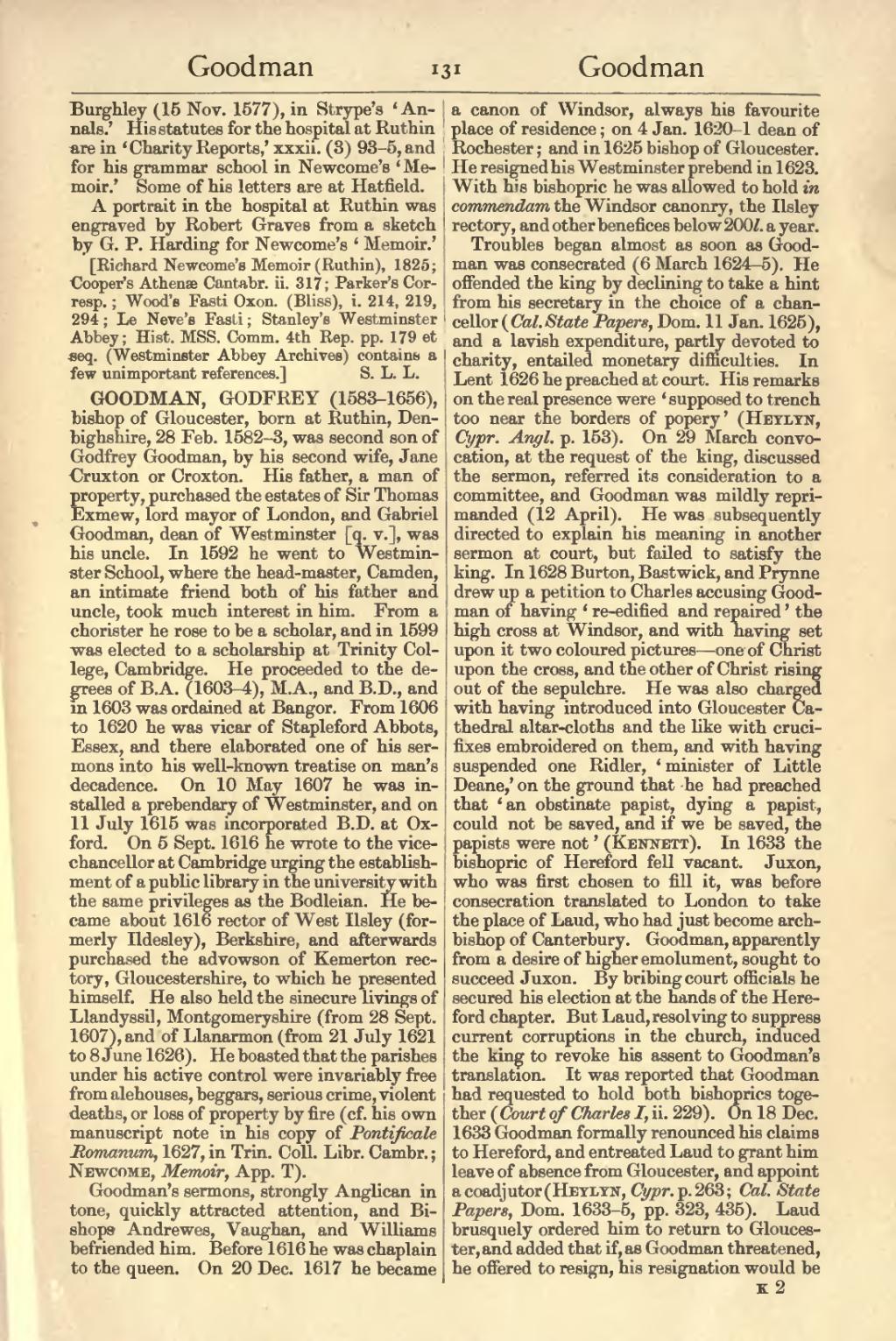Burghley (15 Nov. 1577), in Strype's ‘Annals.’ His statutes for the hospital at Ruthin are in ‘Charity Reports,’ xxxii. (3) 93–5, and for his grammar school in Newcome's ‘Memoir.’ Some of his letters are at Hatfield.
A portrait in the hospital at Ruthin was engraved by Robert Graves from a sketch by G. P. Harding for Newcome's ‘Memoir.’
[Richard Newcome's Memoir (Ruthin), 1825; Cooper's Athenæ Cantabr. ii. 317; Parker's Corresp.; Wood's Fasti Oxon. (Bliss), i. 214, 219, 294; Le Neve's Fasti; Stanley's Westminster Abbey; Hist. MSS. Comm. 4th Rep. pp. 179 et seq. (Westminster Abbey Archives) contains a few unimportant references.]
GOODMAN, GODFREY (1583–1656), bishop of Gloucester, born at Ruthin, Denbighshire, 28 Feb. 1582–3, was second son of Godfrey Goodman, by his second wife, Jane Cruxton or Croxton. His father, a man of property, purchased the estates of Sir Thomas Exmew, lord mayor of London, and Gabriel Goodman, dean of Westminster [q. v.], was his uncle. In 1592 he went to Westminster School, where the head-master, Camden, an intimate friend both of his father and uncle, took much interest in him. From a chorister he rose to be a scholar, and in 1599 was elected to a scholarship at Trinity College, Cambridge. He proceeded to the degrees of B.A. (1603–4), M.A., and B.D., and in 1603 was ordained at Bangor. From 1606 to 1620 he was vicar of Stapleford Abbots, Essex, and there elaborated one of his sermons into his well-known treatise on man's decadence. On 10 May 1607 he was installed a prebendary of Westminster, and on 11 July 1615 was incorporated B.D. at Oxford. On 5 Sept. 1616 he wrote to the vice-chancellor at Cambridge urging the establishment of a public library in the university with the same privileges as the Bodleian. He became about 1616 rector of West Ilsley (formerly Ildesley), Berkshire, and afterwards purchased the advowson of Kemerton rectory, Gloucestershire, to which he presented himself. He also held the sinecure livings of Llandyssil, Montgomeryshire (from 28 Sept. 1607), and of Llanarmon (from 21 July 1621 to 8 June 1626). He boasted that the parishes under his active control were invariably free from alehouses, beggars, serious crime, violent deaths, or loss of property by fire (cf. his own manuscript note in his copy of Pontificale Romanum, 1627, in Trin. Coll. Libr. Cambr.; Newcome, Memoir, App. T).
Goodman's sermons, strongly Anglican in tone, quickly attracted attention, and Bishops Andrewes, Vaughan, and Williams befriended him. Before 1616 he was chaplain to the queen. On 20 Dec. 1617 he became a canon of Windsor, always his favourite place of residence; on 4 Jan. 1620–1 dean of Rochester; and in 1625 bishop of Gloucester. He resigned his Westminster prebend in 1623. With his bishopric he was allowed to hold in commendam the Windsor canonry, the Ilsley rectory, and other benefices below 200l. a year.
Troubles began almost as soon as Goodman was consecrated (6 March 1624–5). He offended the king by declining to take a hint from his secretary in the choice of a chancellor (Cal. State Papers, Dom. 11 Jan. 1625), and a lavish expenditure, partly devoted to charity, entailed monetary difficulties. In Lent 1626 he preached at court. His remarks on the real presence were ‘supposed to trench too near the borders of popery’ (Heylyn, Cypr. Angl. p. 153). On 29 March convocation, at the request of the king, discussed the sermon, referred its consideration to a committee, and Goodman was mildly reprimanded (12 April). He was subsequently directed to explain his meaning in another sermon at court, but failed to satisfy the king. In 1628 Burton, Bastwick, and Prynne drew up a petition to Charles accusing Goodman of having ‘re-edified and repaired’ the high cross at Windsor, and with having set upon it two coloured pictures—one of Christ upon the cross, and the other of Christ rising out of the sepulchre. He was also charged with having introduced into Gloucester Cathedral altar-cloths and the like with crucifixes embroidered on them, and with having suspended one Ridler, ‘minister of Little Deane,’ on the ground that he had preached that ‘an obstinate papist, dying a papist, could not be saved, and if we be saved, the papists were not’ (Kennett). In 1633 the bishopric of Hereford fell vacant. Juxon, who was first chosen to fill it, was before consecration translated to London to take the place of Laud, who had just become archbishop of Canterbury. Goodman, apparently from a desire of higher emolument, sought to succeed Juxon. By bribing court officials he secured his election at the hands of the Hereford chapter. But Laud, resolving to suppress current corruptions in the church, induced the king to revoke his assent to Goodman's translation. It was reported that Goodman had requested to hold both bishoprics together (Court of Charles I, ii. 229). On 18 Dec. 1633 Goodman formally renounced his claims to Hereford, and entreated Laud to grant him leave of absence from Gloucester, and appoint a coadjutor (Heylyn, Cypr. p. 263; Cal. State Papers, Dom. 1633–5, pp. 323, 435). Laud brusquely ordered him to return to Gloucester, and added that if, as Goodman threatened, he offered to resign, his resignation would be
